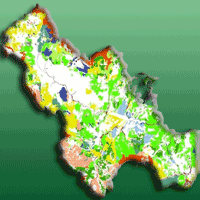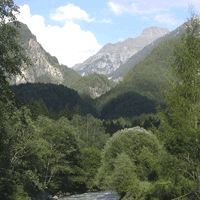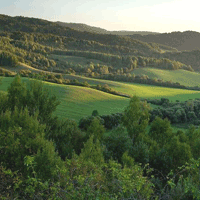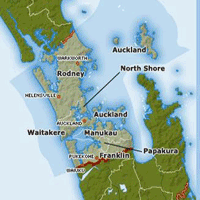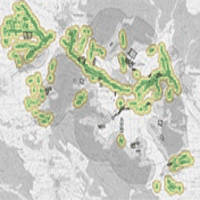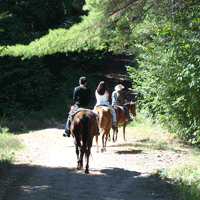
Forest and tourism: economic evaluation and management features under sustainable multifunctionality
iForest - Biogeosciences and Forestry, Volume 2, Issue 5, Pages 192-197 (2009)
doi: https://doi.org/10.3832/ifor0514-002
Published: Oct 15, 2009 - Copyright © 2009 SISEF
Research Articles
Collection/Special Issue: EFI 2008 Annual Conference Week - Orvieto (Italy)
Adaptation of Forest Landscape to Environmental Changes
Guest Editors: Giuseppe Scarascia Mugnozza (CRA - Rome, Italy)
Abstract
The ways in which forests have been used and managed by man have been modified substantially over time in relation to both changes in the economic and social needs of communities and the visions of the world that these have embraced. In recent times, as regards the flows of utility guaranteed by forests, increasing interest has been focused on recreational aspects of the landscape. Such interest derives from both the importance, highlighted by numerous studies, of this aspect and its connection with tourism. The latter phenomenon is undergoing strong growth and is able to trigger important processes of local development. Within this framework, the present study advances some preliminary considerations on the relationships which, from the standpoint of sustainable local development, exist between possible types of tourism and alternative methods of forest management. To this end, it first explores some characteristics of the forest landscape and their possible economic evaluation, in the light of the attributes of excludability and rivalry in consumption. The study then discusses the possible economic role of tourism and the contribution that a suitable forest landscape can make to the sector’s development. Finally, it sets in context modes of forest management and alternative types of tourism development.
Keywords
Sustainable forest management, Tourism, Landscape, Public goods, Local development
Authors’ Info
Authors’ address
Corresponding author
Paper Info
Citation
Gios G, Clauser O (2009). Forest and tourism: economic evaluation and management features under sustainable multifunctionality. iForest 2: 192-197. - doi: 10.3832/ifor0514-002
Academic Editor
Marco Borghetti
Paper history
Received: May 08, 2009
Accepted: Sep 03, 2009
First online: Oct 15, 2009
Publication Date: Oct 15, 2009
Publication Time: 1.40 months
Copyright Information
© SISEF - The Italian Society of Silviculture and Forest Ecology 2009
Open Access
This article is distributed under the terms of the Creative Commons Attribution-Non Commercial 4.0 International (https://creativecommons.org/licenses/by-nc/4.0/), which permits unrestricted use, distribution, and reproduction in any medium, provided you give appropriate credit to the original author(s) and the source, provide a link to the Creative Commons license, and indicate if changes were made.
Web Metrics
Breakdown by View Type
Article Usage
Total Article Views: 77909
(from publication date up to now)
Breakdown by View Type
HTML Page Views: 44851
Abstract Page Views: 3850
PDF Downloads: 28185
Citation/Reference Downloads: 29
XML Downloads: 994
Web Metrics
Days since publication: 5919
Overall contacts: 77909
Avg. contacts per week: 92.14
Citation Metrics
Article Citations
Article citations are based on data periodically collected from the Clarivate Web of Science web site
(last update: Mar 2025)
Total number of cites (since 2009): 10
Average cites per year: 0.59
Publication Metrics
by Dimensions ©
Articles citing this article
List of the papers citing this article based on CrossRef Cited-by.
References
Multiresource forest management: a paradigmatic challenge to professional forestry. Journal of Forestry 88 (4): 12-18.
Gscholar
Compatibilità tra sviluppo della domanda di turismo invernale nelle Dolomiti e sostenibilità ambientale. In: “La Sardegna nel mondo mediterraneo: Quinto convegno internazionale di studi Turismo e Ambiente” (Scanu G ed). Sassari (Italy) 28-30 October 1998. Patron editore, Bologna, Italy.
Gscholar
Land for the future. Johns Hopkins Universiy Press, Baltimore, USA.
Gscholar
L’esperienza delle community forests in Inghilterra. Ri-Vista. Ricerche per la progettazione del paesaggio 4 (6): 1-10.
Gscholar
La gestione dei sistemi locali di offerta turistica. Cedam, Padua, Italy.
Gscholar
Measuring environmental amenity benefits of agricultural land. In: “Farming in the countryside: an economic analysis of costs and benefits” (Hanley N ed). CAB International, Wallingford, UK.
Gscholar
L’economia del paesaggio rurale. Agribusiness Paesaggio e Ambiente 1: 22-39.
Gscholar
La destinazione turistica di successo. Marketing e management. Hoepli, Milan, Italy.
Gscholar
Multiple-use forestry - a concept of communication. In: “Multiple-use forestry in the Nordic countries” (Hytönen M ed). The Finnish Forest Research Institute, Helsinki, Finland, pp. 67-80.
Gscholar
Lo strumento consortile per la gestione e lo sviluppo del territorio nelle aree montane. In: “Cosa apprendere dalla proprietà collettiva. La consuetudine fra tradizione e modernità” (Nervi P ed). Proceedings of the Meeting: “Cosa apprendere dalla proprietà collettiva. La consuetudine fra tradizione e modernità”, Trento (Italy), 14-15 November 2002. Cedam, Padua, Italy, vol. 9: 175-195.
Gscholar
The tourism development handbook: a practical approach to planning and marketing. Thompson Learning, London, UK.
Gscholar
History, evolution and significance of the multiple-use concept. In: “Multiple-use forestry in the Nordic countries” (Hytönen M ed). The Finnish Forest Research Institute, Helsinki, Finland, pp. 43-65.
Gscholar
Concerning the power of content identifying methodologies. In: “Assessment of amenity resources values” (Daniel TC, Zube EH eds). USDA Forest Service Rocky Mountains Station, USA.
Gscholar
La valutazione del danno ai boschi del Friuli Venezia Giulia. In: “La valutazione dei beni ambientali come supporto alle decisioni pubbliche” (Tempesta F, Marangon F ed). Ed. Forum, Udine, Italy, pp. 27-42.
Gscholar
Valuing mediterranean forests. Towards total economic value. CABI Publishing, Wallingford, UK.
Gscholar
Aspetti economici e politici della conservazione del paesaggio rurale. Definizione dello strumento d’indagine per una valutazione economica nell’astigiano. Ph.D. Thesis (XVI cycle), University of Turin, Italy.
Gscholar
Multifunctionality - towards an analytical framework. OECD Publications, Paris, France.
Gscholar
Governing the commons: the evolution of institutions for collective action. Cambridge University Press, Cambridge, MA, USA.
Gscholar
Il valore economico totale come strumento di valutazione della multifunzionalità forestale. Un’analisi teorica e applicazione ai boschi del comune d’Oulx. Ph.D. Thesis, University of Trento, Italy.
Gscholar
La sostenibilità delle common lands: (sotto)sviluppo storico dei meccanismi di governance. Archivio Scialoja-Bolla. Annali di Studi sulla Proprietà Collettiva 1: 61-84.
Gscholar
Economia del turismo: note su crescita, qualità ambientale e sostenibilità. Contributi di Ricerca CRENoS 12.
Gscholar
Il ruolo della selvicoltura nella gestione faunistica. Sherwood 112: 19-23.
Gscholar
Risposte strategiche alla complessità: le forme di offerta dei prodotti alberghieri. Giappichelli, Turin, Italy.
Gscholar
Destination management: gestire prodotti e sistemi locali di offerta turistica. In: “Destination management. Governare il turismo tra locale e globale” (Franch M ed). Giappichelli, Torino, Italy, pp. 11-38.
Gscholar

